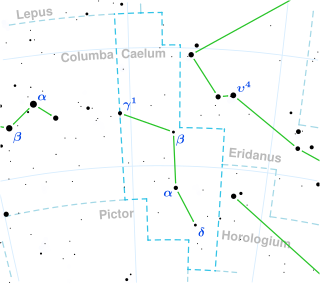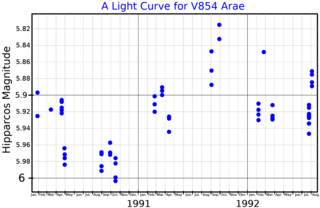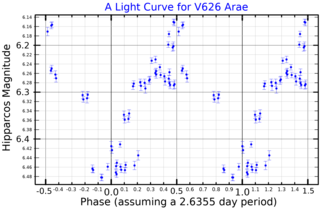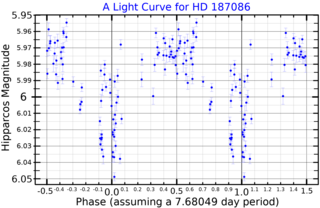3 Centauri is a triple star system in the southern constellation of Centaurus, located approximately 300 light years from the Sun. It is visible to the naked eye as a faint, blue-white hued star with a combined apparent visual magnitude of 4.32. As of 2017, the two visible components had an angular separation of 7.851″ along a position angle of 106°. The system has the Bayer designation k Centauri; 3 Centauri is the Flamsteed designation. It is a suspected eclipsing binary with a variable star designation V983 Centauri.

RV Caeli, also known as HD 28552, is a solitary, red hued variable star located in the southern constellation Caelum, the chisel. It has an apparent magnitude of 6.4, placing it near the limit for naked eye visibility. The object is located relatively far at a distance of 1,340 light years based on parallax measurements from Gaia DR3, but is rapidly receding with a heliocentric radial velocity of 98 km/s.
HD 224635 and HD 224636 is a pair of stars comprising a binary star system in the constellation Andromeda. They are located approximately 94 light years away and they orbit each other every 717 years.

HD 155035 is the Henry Draper Catalogue designation for a star in the constellation Ara, the Altar. It is located at a distance of approximately 1,450 light-years from Earth and has an apparent visual magnitude of 5.92, making it is faintly visible to the naked eye. This is a red giant star with a stellar classification of M1.5 III. It an irregular variable that changes brightness over an amplitude range of 0.12 magnitudes.

HD 160342 is a star in the southern constellation of Ara. HD 160342 is its Henry Draper Catalogue designation. It has an apparent visual magnitude of 6.35 and, based upon parallax measurements, is approximately 960 light-years distant from Earth.
HD 36678 is single star in the northern constellation of Auriga. This star is dimly visible to the naked eye with an apparent visual magnitude of 5.83. It is located at a distance of approximately 840 light years from the Sun based on parallax.

HD 33463 is a suspected variable star in the northern constellation of Auriga, about 1,050 light years away. It is a red giant star with a stellar classification of M2III, and has expanded away from the main sequence after exhausting its core hydrogen. It has reached 133 times the size of the Sun and, at an effective temperature of 3,753 K it shines at a bolometric luminosity of 2,114 L☉.
HD 135438 is a K-type giant star in the northern constellation of Boötes. With an apparent magnitude of 6.0, it lies about 650 light years away.

HD 27245, also known as HR 1335 or rarely 25 H. Camelopardalis is a solitary red-hued star located in the northern circumpolar constellation Camelopardalis. It has an apparent magnitude of 5.4, making it faintly visible to the naked eye. Gaia DR3 Parallax measurements place it approximately 607 light years away from it the Solar System and is drifting further away with a heliocentric radial velocity of 25.2 km/s. At its current distance, HD 27245's brightness is diminished by 0.36 magnitudes due to extinction from interstellar dust. It has an absolute magnitude of −0.27.

V4381 Sagittarii is a variable star in the constellation Sagittarius. A white supergiant of spectral type A2/A3Iab, it is an Alpha Cygni variable that varies between apparent photographic magnitudes 6.57 and 6.62. Its visual apparent magnitude is about 6.54.
HD 91496 is a giant star in the constellation Carina, with an apparent magnitude is 4.92 and an MK spectral class of K4/5 III. It has been suspected of varying in brightness, but this has not been confirmed.
HD 102350 is a single star in the constellation Centaurus. It has a yellow hue and is visible to the naked eye with an apparent visual magnitude of 4.11. The distance to this star is approximately 390 light years based on parallax, but it is drifting closer with a radial velocity of −3 km/s. It has an absolute magnitude of −1.51.

28 Monocerotis is a single star in the equatorial constellation of Monoceros. It has an orange-hue and is faintly visible to the naked eye with an apparent visual magnitude of 4.69. The distance to this star is approximately 450 light years based on parallax, and it has an absolute magnitude of −1.00. The star is drifting further away from the Sun with a radial velocity of +26.7 km/s.

Sigma Ophiuchi, Latinized from σ Ophiuchi, is a single, orange-hued star in the equatorial constellation Ophiuchus. Its apparent visual magnitude is 4.31, which is bright enough to be faintly visible to the naked eye. The annual parallax shift of 3.62 mas as seen from Earth provides a distance estimate of roughly 900 light years. It is moving closer to the Sun with a radial velocity of −28 km/s.

Y Centauri or Y Cen is a semiregular variable star in the constellation of Centaurus.

Iota Mensae is a single star about 880 light years away in the faint constellation Mensa. It has a very slightly variable apparent magnitude of 6.0, making it visible with the naked eye under good skies.
HD 200044 is a solitary star in the equatorial constellation Delphinus. It has an apparent magnitude of 5.7, allowing it to be faintly seen with the naked eye. The object is located 598 light years away, but is approaching the Solar System with a heliocentric radial velocity of −15.07 km/s.

HD 174387 is a solitary star in the southern constellation Telescopium. With an apparent magnitude of 5.49, it is faintly visible to the naked eye if viewed under dark skies. Parallax measurements put the object at a distance of 810 light years and it is currently approaching the Solar System with a heliocentric radial velocity of −28.1 km/s.
HD 1032 is a solitary star in the southern circumpolar constellation Octans. It is faintly visible to the naked eye with an apparent magnitude of 5.77 and is estimated to be 850 light years away from the Solar System based on parallax measure. However, it is receding with a heliocentric radial velocity of 4 km/s.

HD 187086, also known as HR 7537, is a probable astrometric binary located in the southern constellation Telescopium. It has an average apparent magnitude of 5.9, making it faintly visible to the naked eye. The star is located relatively far at a distance of 1,020 light years based on Gaia DR3 parallax measurements but is rapidly drifting closer with a heliocentric radial velocity of −64 km/s. At its current distance, HD 187086's brightness is diminished by 0.27 magnitudes due to interstellar dust. It has an absolute magnitude of −0.8.













